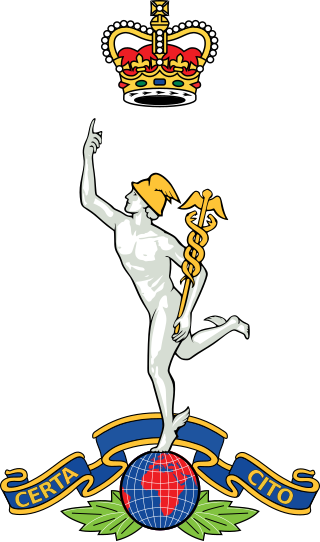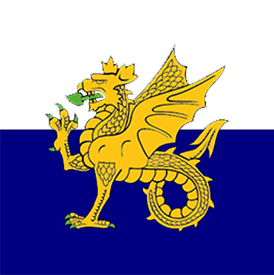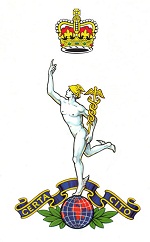
The Royal Corps of Signals is one of the combat support arms of the British Army. Signals units are among the first into action, providing the battlefield communications and information systems essential to all operations. Royal Signals units provide the full telecommunications infrastructure for the Army wherever they operate in the world. The Corps has its own engineers, logistics experts and systems operators to run radio and area networks in the field. It is responsible for installing, maintaining and operating all types of telecommunications equipment and information systems, providing command support to commanders and their headquarters, and conducting electronic warfare against enemy communications.

The 32nd Signal Regiment is a British Army Reserve Regiment of the Royal Corps of Signals. The regiment forms part of 1st Signal Brigade, providing military communications for national operations.
The Queen's Own Warwickshire and Worcestershire Yeomanry (QOWWY) was a regiment of the Royal Armoured Corps, forming part of the Territorial Army (TA). Following reductions in 1969 and 1971 respectively the regiment was reduced to two and later one company sized sub-unit in 1999. Following a reorganisation in 2021, there are now two successors to the regiment: one squadron in the Royal Yeomanry as light cavalry, and one squadron in the 37th Signal Regiment as a support squadron.

The 2nd Signal Brigade, was a military formation of the British Army composed of Royal Corps of Signals units. The brigade was first formed following the reorganisation of the old Territorial Army in 1967, and was disbanded in 2012 under the Army 2020 programme. However, later the 2nd Signal Group was formed continuing the lineage of the old brigade, before it was disbanded in 2018.

The 31st Signal Regiment was a territorial communications regiment of the British Army's Royal Corps of Signals. The regiment first formed following the creation of the Territorial and Army Volunteer Reserve in 1967 after the 1966 Defence White Paper. After seeing limited reserve support during the Cold War, the regiment was disbanded in 2010 following the initial Army 2020 reform.

39th (Skinners) Signal Regiment is an Army Reserve regiment in the Royal Corps of Signals in the British Army. The regiment forms part of 1 Signal Brigade, providing military communications for national operations. The Lynx badge is a reminder of the unit's connection with the Worshipful Company of Skinners.

34 (Northern) Signal Regiment was a Territorial Army regiment in the Royal Corps of Signals in the British Army. The regiment formed part of 12 Signal Group, providing command and control communication for NATO's Allied Rapid Reaction Corps (ARRC). As a result of the Strategic Review of Reserves it was announced on 28 April 2009 that the regiment was to be disbanded The regiment consisted of three squadrons plus the band:

37th Signal Regiment is a military communications regiment of the Royal Corps of Signals, part of the British Army. The regiment was one of ten Territorial Army,, units formed following the complete reorganisation of the Territorial Army in 1967. Until the Army 2020 programme in 2012, the regiment provided national communications support and its squadrons providing support to the regional brigades, notable 143rd and 160th (Welsh) Brigades. However, from 2014 the regiment was re-roled and now paired with 2nd Signal Regiment supporting 1st Division.

The Home Service Force (HSF) was a Home Guard type force established in the United Kingdom in 1982. Each HSF unit was placed with either a Regular Army or Territorial Army regiment or battalion for administrative purposes and given that formation's title, cap badge and recruited from volunteers aged 18–60 with previous British forces experience. It was introduced to guard key points and installations likely to be the target of enemy special forces and saboteurs, so releasing other units for mobile defence roles. It was stood down in 1992.
53 Signal Squadron is an Army Reserve squadron in the Royal Corps of Signals in the British Army. The only Reserve Royal Signals unit in Wales, it is based in Cardiff. "The Welsh Signallers" provide information and communication systems to the armed forces, emergency services and other government departments. Recently, the Squadron has been involved in support to the Olympic Games, covering strike action for essential services, security for the NATO Summit at the Celtic Manor and providing part of the flood relief efforts.

1 Signal Squadron was a British Territorial Army Squadron of the Royal Corps of Signals.
10 Signal Regiment is a signal regiment of the Royal Corps of Signals within the British Army.

21 Signal Regiment is a signal regiment of the Royal Corps of Signals within the British Army. The regiment was, until the initial Army 2020 reforms, the only signal regiment to support the Royal Air Force.
The Glamorgan Fortress Royal Engineers was a Welsh Territorial Army (TA) unit of Britain's Royal Engineers, first raised in 1885 as a Volunteer unit of Submarine Miners to defend the Severn Estuary. During World War I it carried out defence work in England and Gibraltar, and detachments served on the Western Front. In World War II it served in the North African campaign, including the Second Battle of El Alamein, and the Allied invasion of Sicily. Postwar, the unit continued in the TA until 1961.

The City of London Signals was a Territorial Army unit of the British Army's Royal Corps of Signals. It had its origins in a signal company of the Royal Engineers formed in 1908 and during World War II it provided the divisional signals for the 56th (London) Division and its duplicates as well as communications for the Royal Air Force in the Middle East. Its successors continued in the postwar Territorial Army and Army Reserve until 2016.

43 (Wessex) Signal Regiment was a Territorial Army (TA) unit of the British Army's Royal Corps of Signals from 1920. It had its origins in a Volunteer unit of the Royal Engineers formed in the West Country in 1860 and provided the communications for the 43rd (Wessex) Infantry Division during World War II. Its successor still serves as a squadron in today's Army Reserve.
The 4th (Volunteer) Battalion, The Worcestershire and Sherwood Foresters was a former territorial infantry battalion that existed for a short time towards the end of the Cold War. Following reductions to the Territorial Army (TA) in 1992, the battalion was disbanded with elements helping to form RHQ & HQ Sqn of 37 Signal Regiment, and 96 Signal Squadron. This squadron was then reduced to a signal troop in 2009, but continues to exist as part of 48 Signal Squadron.

Central Volunteer Headquarters, Royal Corps of Signals is a special administrative group of the Royal Corps of Signals formed to oversee the national reserve units of the corps.

The 9th Special Communications Unit, later redesignated as the 92nd Signal Regiment, and from 1967 as 2 Signal Squadron is a communications unit of the British Army, belonging to the Royal Corps of Signals.






